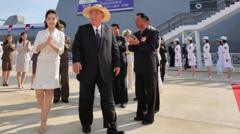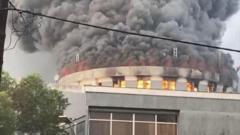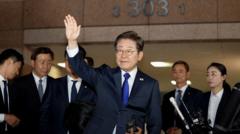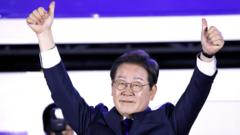In a show of defiance, North Korea has conducted its first ballistic missile launch in two months, escalating tensions on the Korean Peninsula amidst significant political upheaval in South Korea.
North Korea Launches First Ballistic Missile in Two Months Amid Rising Tensions

North Korea Launches First Ballistic Missile in Two Months Amid Rising Tensions
North Korea's missile launch comes as US Secretary of State Antony Blinken engages in talks in Seoul with South Korean leaders.
North Korea has fired an intermediate-range ballistic missile towards the sea to its east, according to South Korea's military. This launch marks Pyongyang's first missile test since November, when a series of missile firings coincided with the U.S. presidential election. The South Korean military reported that the missile traveled approximately 1,100 kilometers before landing in the sea, deeming the act a "clear provocation" that warrants strong condemnation.
This launch occurs concurrently with U.S. Secretary of State Antony Blinken's visit to Seoul, where he is discussing key alliances with significant South Korean leaders, including acting president Choi Sang-mok. Blinken emphasized that the partnership between Washington and Seoul is essential for the peace and stability of the Korean Peninsula. In light of the recent missile activity, South Korea's military has intensified surveillance efforts and is actively sharing intelligence with the United States and Japan concerning the developments in the region.
Amidst these tensions, South Korea is grappling with domestic political turmoil, triggered by the impeachment of President Yoon Suk Yeol after his controversial attempt to impose martial law. This chaotic landscape may present an opportunity for North Korea to assert itself further. Kim Jong Un's administration has historically criticized Yoon's governance, branding past actions as representative of a "fascist dictatorship" while bolstering its own cult of personality.
In the backdrop of these military provocations, previous missile tests in November attracted significant international attention, particularly in light of the U.S. conducting military drills that involved long-range bombers alongside South Korea and Japan. North Korea's reaction to these drills was swift, as Kim Yo Jong condemned them as threats to the North.
As global observers continue to monitor this evolving situation, questions remain about the implications of North Korea's recent actions and how they may affect the geopolitical landscape in East Asia.
This launch occurs concurrently with U.S. Secretary of State Antony Blinken's visit to Seoul, where he is discussing key alliances with significant South Korean leaders, including acting president Choi Sang-mok. Blinken emphasized that the partnership between Washington and Seoul is essential for the peace and stability of the Korean Peninsula. In light of the recent missile activity, South Korea's military has intensified surveillance efforts and is actively sharing intelligence with the United States and Japan concerning the developments in the region.
Amidst these tensions, South Korea is grappling with domestic political turmoil, triggered by the impeachment of President Yoon Suk Yeol after his controversial attempt to impose martial law. This chaotic landscape may present an opportunity for North Korea to assert itself further. Kim Jong Un's administration has historically criticized Yoon's governance, branding past actions as representative of a "fascist dictatorship" while bolstering its own cult of personality.
In the backdrop of these military provocations, previous missile tests in November attracted significant international attention, particularly in light of the U.S. conducting military drills that involved long-range bombers alongside South Korea and Japan. North Korea's reaction to these drills was swift, as Kim Yo Jong condemned them as threats to the North.
As global observers continue to monitor this evolving situation, questions remain about the implications of North Korea's recent actions and how they may affect the geopolitical landscape in East Asia.



















